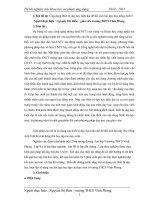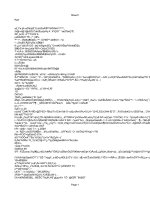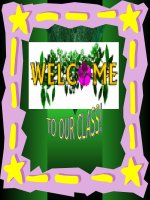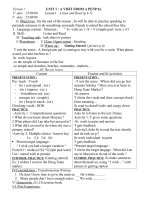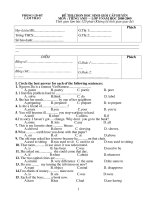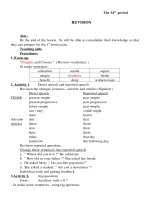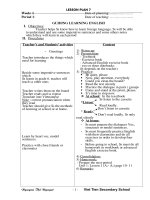GA Tiếng Anh 9 mẫu
Bạn đang xem bản rút gọn của tài liệu. Xem và tải ngay bản đầy đủ của tài liệu tại đây (1.25 MB, 69 trang )
Trêng THCS S¬n LÔ
UNIT 1: A VISIT FROM A PEN PAL
I. General objectives:
1. Competencies:
- Make & respond to introduction
- How to compare with the likeness and the difference.
- Scan for specific information.
2. Language focus:
- Past simple tense
- Present unreal wish
II. Techniques: Brainstorming; Questions – answers
III. Etching aids: Cassette; Cassette recorder; illustrating pictures; OPH;
Pictures; Visual aids; Laptop; Flash cards, colored chalk.
IV. Total period distribution:
Period distribution Items of Teaching
1 Getting started, Listen and read
2 Speak and Listen
3 Read
4 Write
5 Language focus
Lesson 1: Getting started – Listen and read (45 min)
I. Objectives:
- Introduce, leading to the topic of a unit
- Talking about places to visit
II. Grammar: Wish sentence & Past habit Used to + Verb
III. Vocabulary: Words relating to famous place to visit & activities done during
the visit
Steps Teacher’s activities Student’s activities
Warm – Up
(15’)
* Getting started.
- Showing 6 pictures of places of
interest of Vietnam
- Eliciting the places of interest of Ho
- Looking at the 6 pictures
and guessing what places
they are.
Grade 9 1 Teacher: NguyÔn ThÞ Thu HuyÒn
1
Trêng THCS S¬n LÔ
Lead-in
(30’)
Chi Minh City
- Asking them some questions
1. Do you have any pen pals?
2. Do you like to have pen pals?
3. Where will you take him if he
visits Vietnam for the 1
st
time?
4. Can you tell me the names of the
places in 6 pictures?
- Teaching new words: Hung Temple;
Temple of Literature; Dong Xuan
Market; the City hall; Ho Chi Minh
history museum; Ben Thanh market.
* Listen and read
- Introducing the situation of the
passage: Rizal Mary is, Lan’s pen pal
visited her for the fist time and Lan took
her to some places of interest in Hanoi.
- Playing cassette once the 1
st
paragraph.
- Asking them questions: What do you
know about Mary am?
- Having them a silent reading then
identifying the places of interest.
- Playing cassette again.
- Explaining the new difficult words:
Mosque; peaceful; keep in touch;
atmosphere
- Reminding them of new and old
structures.
* Old Structure: Past habit
Used to + V
* Ex: Lan used to walk past the mosque
on her way to primary school.
* New structure:
Wish sentence: Present unreal wish
* Ex: I wish I had more time.
- Asking them to have silent reading for
information to answer the questions.
- Calling some students to say their
choices.
- Answering the questions.
- Listening to the teacher’s
explanations then write the
vocabulary down.
- Listening to the teacher
- Listening to cassette.
- Answering the question.
- Having a silent reading.
- Listening to the cassette.
- Writing down the new
words.
- Finding out structures.
- Identifying new structures.
- Having silent reading and
get more information.
- Saying the choices.
Grade 9 2 Teacher: NguyÔn ThÞ Thu HuyÒn
2
Trêng THCS S¬n LÔ
- Briefly explaining the use of Wish
Ex: I wish I had more time.
I wish + clause (Past simple)
Practice:
1. I don’t have enough money.
I wish …………………………
2. I can’t sing that song
I wish …………………………
3. It’s raining.
I wish …………………………
4. I am too fat.
I wish …………………………
5. The weather is bad to day.
I wish …………………………
- Doing the practice.
1. I wish I had enough
money.
2. I wish I could sing that
song.
3. I wish it wasn’t raining.
4. I wish I weren’t too fat.
5. I wish the weather were
fine today.
Consolidation
1. Where did Lan take Mary am to
visit?
2. What place did they visit on Friday?
3. What new structure is there in the
passage?
Homework
- Do exercise 1 workbook
(p.5-6).
- Explain the way how to do
these exercises.
Grade 9 3 Teacher: NguyÔn ThÞ Thu HuyÒn
3
Trêng THCS S¬n LÔ
UNIT 1: A VISIT FROM A PEN PAL
Lesson 2: Speak – Listen (45 min)
I. Objectives:
- Developing speaking and listening skills.
- Introducing oneself
II. Language contents:
1. Grammar: Yes – No questions.
2. Vocabulary: Some words relating to capitals and big cities in
the word, especially in Asia.
III. Techniques:
Asking and answering – Pair work – Role play – Matching.
IV. Teaching aids:
Pictures, cassette player and tape.
V. Time: 45 minutes
VI. Procedures:
SPEAK (28 minutes)
Steps Teacher’s activities Student’s activities
Warm – up
(3’)
- Making questions:
1. Where does Mary is come from?
2. Does she like Vietnamese people?
3. Does she like Ha Noi?
- Answering the questions:
1. Malaysia – Kuala Lumpur
2. Friendly
3. Interesting
Presentatio
n (7’)
- Introducing situation.
- Asking Sts to work in pairs.
- Matching and putting the
dialogues in the correct order.
Finishing part (a)
Practice
(13’)
- Correcting part (a)
- Sticking the answer key on the board.
- Asking Sts to read the information in
three boxes at the end of the page 8.
- Replacing
- Making similar dialogues.
- Practicing new dialogues (Pair
work)
Grade 9 4 Teacher: NguyÔn ThÞ Thu HuyÒn
4
Trêng THCS S¬n LÔ
Free
practice (5’)
- Asking Sts to match countries and their
capitals (ASIA).
- Asking Sts to play roles.
- Matching
- Playing roles with their old names
and their own words.
LISTEN (17 minutes)
Steps Teacher’s activities Student’s activities
Pre-listening
(3’)
- Introducing the lesson - Looking at the picture and taking
about them.
While-
listening
(10’)
- Taking about the situation
of the lesson.
- Playing the tape.
- Listening and finding out where
Tim and Carol are and that they
are doing.
- Listening and choosing the
correct answers.
- Comparing their answers with the
partner’s.
Post-
listening (4’)
- Checking the answers with the whole
class.
- Saying the answers.
Grade 9 5 Teacher: NguyÔn ThÞ Thu HuyÒn
5
Trêng THCS S¬n LÔ
UNIT 1: A VISIT TO A PEN PAL
Lesson 3: Read (45 min)
I. Objectives:
1. Developing speaking and listening skills.
2. Help students to know more about Malaysia.
II. Language contents:
Vocabulary: divided, separated, comprise tropical climate, official,
language of instruction.
III. Techniques:
Communicative approach.
IV. Procedures:
Steps Teacher’s activities Student’s activities
Warm-up
- T shows the map of Vietnam and asks
students:
1. Which country is on the map?
2. Which city is the capital of
Vietnam?
3. How many regions are there in
Vietnam?
- Answering the questions.
Pre-reading
- T introduce a the passage by showing
the map and the picture about
Malaysia.
- T asks “What do you know about
Malaysia.
- T asks sts to read the passage silently
and underline the new words.
- T explains new word (translation
method)
- Sts answer (in Vietnamese)
- Reading the passage in silently
an underline the new word
- Listening to the explanation.
While-
reading
- T reads the passage and students
listen and find the right information
about Malaysia to fill in the table. (pair
word)
- Sts read their answer sentences.
Post-reading
- T hangs a cardboard and gets sts to do
T/F exercises in pairs.
- T asks some pairs to write their
- Doing the exercise in pairs.
- Answering the questions.
Grade 9 6 Teacher: NguyÔn ThÞ Thu HuyÒn
6
Trêng THCS S¬n LÔ
answers on the board.
- T gives answer keys and corrects
them.
- Correcting the mistakes.
Feed-back
- T asks. For the false statements T asks
sts to give the correct ones.
- Giving the correct statements.
Consolidatio
n
- T gives some questions about
Malaysia:
1. Is Malaysia one of the countries of
the ASEAN?
2. How many regions are there?
3. Is Kuala Lumpur the largest city in
the country?
4. Which language is taught on
secondary school?
5. What’s the weather like in Malaysia?
- Answering the questions.
Homework
- Learning the new words by
heart.
- Rereading the passage.
Grade 9 7 Teacher: NguyÔn ThÞ Thu HuyÒn
7
Trêng THCS S¬n LÔ
UNIT 1: A VISIT TO A PEN PAL
Lesson 4: Write (45 min)
I. Aims:
Sts can practice the skill of writing a letter (a normal letter and a friendly
letter)
II. Teaching aids:
Pictures of some places of interest ( Hoan Kiem Lake, West Lake, London
Bridge, etc), Overhead, projector.
III. Teaching steps:
Steps Teacher’s activities Student’s activities
Warm-up
- T introduces the topic of the
lesson by telling the sts his/her
trip. Then T ask sts some
questions:
a. When did you go last
summer?
b. Do you have any relatives?
c. Have you ever visited them?
d. Could you tell us about your
trip?
- Answering the
questions.
Presentation
- T reads a sample letter.
- T guides sts how to write a
letter (address, heading, body,
closing, signature…)
- Listening to the teacher.
Practice
- T has some sts read their
letters in front of the class.
- T corrects the mistakes.
- Sts read the outline, pay
attention to he content of
each part.
- Sts base on the outline
and teacher’s instructions
and write a letter.
- Sts discuss in groups and
write letters by
themselves.
Consolidation
- How to write a friendly letter
Grade 9 8 Teacher: NguyÔn ThÞ Thu HuyÒn
8
Trêng THCS S¬n LÔ
Homework
- Sts write letters to invite
their friends to their
places where they are
living, tell them what
they’ll do, what food
they’ll eat …
UNIT 1: A VISIT FROM A PEN PAL
Lesson 5: Language focus (45 min)
I. Objectives:
Students can retell their preparations before a special occasion and express
their wish.
II. Language content:
Grammar: Revision:
- Past simple.
- Wish sentence.
III. Technique:
Question – Answer.
IV. Teaching aid:
Pictures, colored chalk.
V. Procedure:
Teacher’s activities Student’s activities
Past simple
(page 11)
Exercise 1 page 11
- Creating the situation by
asking some questions:
1. Where was Mary am
last week?
2. What did she do in her
first day in HN ?
- Asking the students to pick
out the tenses in 2 answers.
- Having some students give
the formation of past simple
tense.
- Asking the students to do
- Answering the T/s
questions.
1. She was in HN
2. Lan took her to HOAN
KIEM lake.
1. What did Lan do on the
Grade 9 9 Teacher: NguyÔn ThÞ Thu HuyÒn
9
Trêng THCS S¬n LÔ
Exercise 2 page 12
Exercise 3 page 12
The past simple with wish:
S1 V1 S2 V2
I wish you had a longer
vacation.
S1 V1 S2 V2
I wish I had more time.
S1 + WISH S2 + verb
_be (were)
_/v(past)
Consolidation
Homework
pair word (exercise 1)
- Having some pairs present in
front of the class.
- Having the students do group
work and the quickest group
present their key on the board.
- Creating the situation by
asking questions:
“What did Lan say to Mary
am at the end of the week?”
- Asking the students to
analyze the sentence.
- Having the students
withdraw conclusion.
- Asking the sts to do exercise
3 page 12 (group work)
- Having some of the sts write
their sentences on the
blackboard.
- Giving comments or corrects
the mistakes if necessary.
- Asking the sts to give the
formation of wish sentence.
- Asking the sts to write five
wish sentences.
Weekend?
- She went to the concert.
2. When did she go there?
- She went there on
Saturday at 8pm.
Exercise 2:
- Lan made a cake
- Tan hang colorful lamps.
- They bought flowers.
- Huy paint a picture of HN
- They went shopping.
Exercise 3:
- “ I wish you had a longer
vacation”
- Wish sentence => a
complex sentence.
- Verb is used in the past
subjunctive.
Exercise 3:
a. I wish I were taller
b. I wish it were not so
hot
c. I wish I had a
computer
d. I wish I didn’t do it’s.
Grade 9 10 Teacher: NguyÔn ThÞ Thu HuyÒn
10
Trêng THCS S¬n LÔ
UNIT 2: CLOTHING
I. General objectives:
1. Competencies:
- Ask and answer about habits and personal taste of dreading.
- How to present personal ideas in written form about the simple.
- Problems referred to the topic using the readily-given prompts.
2. Language focus:
- The present perfect tense.
- Passive voice review.
II. Techniques:
Brainstorming; Questions – answers.
III. Teaching aids:
Cassette; Cassette recorder; illustrating picture; OPH; Picture; Visual aids;
Laptop; Flash cards; colored chalk.
IV. Total period distribution: 6 periods.
Period distribution Items of Teaching
1 Getting started, Listen and read
2 Speaks
3 Listen
4 Read
5 Write
6 Language focus
Lesson 1: Getting started – Listen and read (45min)
I. Objectives:
- Introduce, leading to the topic of a unit: The traditional Ao Dai of Vietnam
- Remind them of some countries the word with their customs.
II. Grammar: The present perfect tense.
III. Vocabulary: word relating to ways of dressings.
Steps Teacher’s activities Student’s activities
Grade 9 11 Teacher: NguyÔn ThÞ Thu HuyÒn
11
Trêng THCS S¬n LÔ
Warm-up
• Getting started (15’)
- Showing 6 pictures of people with
their costumes.
- Eliciting the name of some countries.
- Asking them some questions.
1. Where does she come from?
2. Why do you know she come from
Japan?
- Teaching new words; a kimono; a
sari; a veil.
- Calling some group reprentatives to
answer in front of the class.
- Correcting their mistakes if possible.
- Looking at the 6 pictures and
guessing what countries they are.
- Answering the questions.
- Discussing in groups.
* Sample Key:
1. She comes from Japan
2. She comes from Vietnam
3. He comes from Scotland.
4. She comes from India.
5. He comes from the USA.
6. She comes from (Saudi)
Arabia.
- Listening to the teacher’s
explanations then wire the
vocabulary down.
Leas-in
(30’)
• Listen and read (30’)
- Introducing the situation of the
passage.
“ Ao dai is the traditionally unique
dress of Vietnam. They are being
used by both man and woman in
specific occasions. It has now being
changed in different designs for
fashion.”
- Playing cassette once the
1
st
paragraph.
- Asking them questions:
1. What is Ao Dai?
2. What are women do
nowadays?
3. What do women also
prefer?
4. What do the designer do
to the Ao Dai?
- Having them a silent reading then
- Listening to the teacher.
- Listening to cassette.
- Answering the question.
- Having a silent reading
Grade 9 12 Teacher: NguyÔn ThÞ Thu HuyÒn
12
Trêng THCS S¬n LÔ
identifing the main idea of the
passage.
- Playing cassette again.
- Explaining the new difficult words;
“poet’ mention; consist; of; to slit;
inspiration; unique; convenient;
along silk tunic; ethnic minoritres”
- Reminding them of new and old
structures:
1. Old Structure: Past habit
2. Used to + V
Eg: Lan used to walk past the mosque
on her way to primary school.
3. New structure:
Wish sentence: Present unreal wish
Eg: I wish I had more time
- Asking them to have silent reading
for information to answer the
questions.
- Calling some students to say their
choices.
- Briefly explaining the used of wish.
=> I wish I had more time.
I wish + clause (Past simple)
Practice:
1. I don’t have enough money.
I wish …………………………
2. I can’t sing that song.
I wish …………………………
3. It’s raining.
I wish …………………………
4. I am too fat.
I wish …………………………
5. The weather is bad today
I wish …………………………
- Listening to the cassette.
- Writing down the new words
- Finding out structures.
- Identifying new structure.
- Having silent reading and get
more information.
- Saying the choices.
- Doing the practice
1. I wish I had enough money
2. I wish I could sing that song
3. I wish it’s wasn’t raining
4. I wish I weren’t too fat
5. I wish the weather were fine
today.
Consolidatio
n
- The present perfect tense.
- Traditions in some countries.
Home work
- Completing the sentences and
Grade 9 13 Teacher: NguyÔn ThÞ Thu HuyÒn
13
Trêng THCS S¬n LÔ
answer the questions. (Page 14)
Grade 9 14 Teacher: NguyÔn ThÞ Thu HuyÒn
14
Trêng THCS S¬n LÔ
UNIT 2: CLOTHING
Lesson 2: Speak (45 min)
I. Objectives:
1. Competencies:
- Develop speaking skill.
- Ask & answer about the hobby and the habits of dressing.
2. Language focus:
a. Grammar:
- The Simple Present Tense
- The Simple Past Tense
b. Vocabulary:
- A colorful T-shirt; a plaid skirt; a plain suit; a short-sleeved; blouse; a
sleeveless sweater; a striped shirt; baggy pants; faded jeans; blue shorts.
II. Techniques:
Brainstorming; questions – answers; guessing
III. Teaching aids:
Cassette; cassette recorder; illustrating pictures; ohp; pictures; visual aids;
laptop; flashcards; colored chalk.
IV. Teaching steps:
Steps Teacher’s activities Student’s activities
Warm – Up
Presentation
Pre-speaking
- Asking students to answer some
questions about clothes:
1. What type of clothing do you
wear at school?
2. What’s this? It’s a skirt / a blouse
…
- Introducing some new words referred
to kinds of clothiers.
- Asking some questions:
1. What do you usually wear on the
weekends?
2. Why are you wearing these clothes?
- Listening to the teacher’s
questions and answer.
- Looking at the new words and
repeats after the teacher.
- Learning the new vocabularies.
- Answering the questions in pairs.
Grade 9 15 Teacher: NguyÔn ThÞ Thu HuyÒn
15
Trêng THCS S¬n LÔ
3. What is your favorite type of
clothing? Why?
4. School uniform: is it comfortable?
5. What color is it?
- Asking them to match the pictures
the given words.
- Matching thru picture with the
words.
* Key:
a. A sleeveless sweater (5)
b. A striped shirt (6)
c. A plain suit (3)
d. Faded jeans (8)
e. A short-sleeved
f. A blouse
g. Baggy pants (7)
h. A plaid skirt (2)
i. Blue shorts (9)
Practice
While-
speaking
Controlled
practice
- Letting the students to ask each other
in groups about their habit of
dressings.
- Correcting their mistakes in spelling.
- Calling some groups to present their
interview before class.
- SS ask the members of the other
group about the clothes they wear
on the weekend.
- Presetting their interview before
class.
Reproduction
Post-
speaking
- Asking the students to answer the
questions :
1. What type of clothing do you wear
on tet holiday?
2. What would you wear to a party?
- Asking them to summarize what kind
of clothes they usually wear at school,
at the party or on Tet holidays.
- Answering the questions.
- Summarizing the habit of
dressing on special occasion.
Consolidatio
n
- Making up another conversation
between you and your friend referred
to the habits of dressing on special
occasion.
- Reminding them the questions “What
is your favorite type of clothing?”
Homework
- Doing exercise 3, 4 workbook
(page 14.15)
Grade 9 16 Teacher: NguyÔn ThÞ Thu HuyÒn
16
Trêng THCS S¬n LÔ
- Explaining the way how to do
the exercises.
UNIT 2: CLOTHING
Lesson 3: Listen (45 min)
I. Objectives:
1. Competencies:
- Developing reading skills.
- Listening for realistic information about some event.
2. Language focus:
a. Grammar:
Passive construction of past simple.
b. Vocabulary:
Attention; special; announce; entrance; wear; long-sleeved blouse;
information desk.
II. Techniques:
Brainstorming; Questions – answers; guessing.
III. Teaching aids:
Cassette; Cassette recorder; illustrating pictures; OHP; Pictures; Laptop;
Flash cards; colored chalk.
IV. Teaching steps:
Steps Teacher’s activities Student’s activities
Warm – Up
Presentation
Pre-speaking
- Introducing the pictures divided into
three groups of different clothes.
- Asking them some questions to
remind them the vocabulary questions:
1. What do you call these clothes in
English?
2. Have you ever worn them?
- Introducing the situation of the
- Looking at the pictures and
discuss their names on groups.
- Answering the questions.
- VOC: trousers; shorts; skirt;
blouse; sandals; shoes; boots
- Yes, we have
- Listening to the situation.
Grade 9 17 Teacher: NguyÔn ThÞ Thu HuyÒn
17
Trêng THCS S¬n LÔ
coming announcement.
“Mary, a three-year-old girl is
reported missing at the Car Fair”
- Asking them to listen and catch up
with the information “What is Mary
wearing?”
- Listening, and then catching up
with the necessary information.
While-
listening
- Playing cassette twice without pause.
- Letting them guess in pairs “What is
Mary wearing?”, then compare with
the pictures.
- Marking the correct pictures.
- Play cassette again.
- Letting them make a good choice.
- Listening to the cassette.
- Doing pair work.
- Marking the pictures.
- Listening again.
- Making a good choice.
* Tape script:
Attention please. Here is a special
announcement. A little girl is
reported missing. She was last
seen 20 minutes ago near the
main entrance to the Car Fair. Her
name’s Mary and she are 3 year
old. She has short dark hair. She is
wearing shorts-blue shorts and a
long-sleeved white blouse. She’s
wearing a pair of shoes – brown
shoes. She may be carrying a
large doll.
If you see Mary, please bring
her to the information desk. Her
father’s waiting for her there.
Thank you.
Post-
listening
- Asking the students to compare their
choices with partner.
- Calling some students to give the
answer.
- Giving them the key
- Comparing their choice with
partner.
- Saying the choices before class.
- Listening to the key and correct.
* KEY:
1. She’s wearing blue shorts.
2. She’s wearing a long-sleeved
white blouse.
3. She’s wearing brown shoes.
Consolidatio
n
- Repeating the words referred to
clothes by looking at the pictures.
- Reminding them the passive
Grade 9 18 Teacher: NguyÔn ThÞ Thu HuyÒn
18
Trêng THCS S¬n LÔ
structure.
Homework
- Doing exercise 5, 6 workbook
(page 16,17)
- Explaining the way how to do
the exercises.
Grade 9 19 Teacher: NguyÔn ThÞ Thu HuyÒn
19
Trêng THCS S¬n LÔ
UNIT 2: CLOTHING
Lesson 4: Read (45 min)
I. Objectives:
1. Competencies:
- Developing reading skill.
- Searching for information about the history of the development of jeans.
2. Language focus:
a. Vocabulary: words related to the history of jeans: sailor; embroidered
jeans; label; generation worldwide.
b. Grammar: passive voice (past simple).
II. Techniques:
Scanning; Questions – answers; guessing.
III. Teaching aids:
Map; cassette; Cassette recorder; illustrating pictures; OHP; Pictures;
Laptop; Flash cards; colored chalk; visual aids.
IV. Teaching steps:
Steps Teacher’s activities Student’s activities
Warm – Up
Presentation
Pre-speaking
- Introducing the new reading by
asking some questions:
1. Do you know jeans?
2. Do you like wearing jeans?
3. Who loves wearing jeans?
4. When did jeans appear for the
first time?
- Encouraging the students make some
questions about jeans:
“What do you want about jeans?”
question for elicit.
- Having scanning: (task 1)
- Reading quickly to find down the
new words and the information (page
17)
- Listening to the teacher’s
introduction.
- Answering the questions freely.
- Making questions randomly.
- Reading the passage for missing
information.
While-
- Introduction some vocabularies. - Listening to the teacher to know
Grade 9 20 Teacher: NguyÔn ThÞ Thu HuyÒn
20
Trêng THCS S¬n LÔ
reading
- Asking the students to have a silent
reading to do the gap filling A.
- Playing cassette twice.
- Calling some students to read the text
aloud.
- Task 2: asking the students to do task
B in pairs.
the moaning of new words.
- Having a silent reading
- Doing gap filling.
- Listening to the cassette.
- Reading the text aloud.
- Doing talk B in pairs.
- Lestening to the cassette.
- Reading the text aloud.
- Doing taks B in pairs.
Post-
listening
- Calling some students to answer the
questions before class.
- Correcting their answers by giving
them key.
- Listening to the keys.
- Correcting their answers.
Consolidatio
n
Do you like wearing Jeans?
Where do jeans come from?
Who are now often wearing Jeans?
Why?
Homework
- Doing exercise 8, 9 workbook
(page 18,19)
Grade 9 21 Teacher: NguyÔn ThÞ Thu HuyÒn
21
Trêng THCS S¬n LÔ
UNIT 2: CLOTHING
Lesson 5: Write (45 min)
I. Objectives:
1. Competencies:
- Developing writing skill.
- Know how to write a paragraph about the secondary school student’s
wear.
2. Language focus:
a. Grammar:
The simple present tense.
b. Vocabulary:
Be equal in; be pound of; bear one’s name; freedom of choose; self-
confident; feel comfortable.
II. Techniques:
Questions – answers; guessing.
III. Teaching aids:
Sample form of a letter; OHP; Pictures; Laptop; Flash cards; colored chalk;
visual aids.
IV. Teaching steps:
Steps Teacher’s activities Student’s activities
Warm – Up
Pre-writing
Pre-speaking
- Introducing the table showing the
three parts of showing comments on
something or a problem using
appropriate argumentative language
(page 18)
- Asking the students to read the topic
and outline A and the model passage
supporting the idea that secondary
students should wear uniforms…
- Asking them some questions:
1. “What type of clothing do you wear
at school?” (White shirt and trousers).
- Looking at the table then discuss
in pairs.
- Identifying the appropriate
argumentative language.
- Reading the topic and outline a
and the model passage, the
highlight the sequence words.
- Answering the questions.
Grade 9 22 Teacher: NguyÔn ThÞ Thu HuyÒn
22
Trêng THCS S¬n LÔ
2. Why do they wear uniform at
school?
- Explaining some new words (be
equal in, be proud of, bear one’s
name, freedom of choice, self-
confident)
- Listening to the explanations,
While-
reading
- Letting them read the outline B.
- Giving them the meaning of some
words: feel comfortable, freedom of
choice.
- Asking them discuss in groups outline
B then write down their ideas.
- Asking some students to write their
ideas on the board.
- Reading outlines B.
- Knowing the meaning of some
difficult words.
- Discussing in groups outline B
then do the draft of the second
passage.
- Writing down their ideas in
written forms.
Post-writing
- Correcting the mistakes.
- Giving them suggested writing (see
at the end of lesson plan).
- Correcting the mistakes
- Writing down the suggested
passage.
Consolidatio
n
“Why should the secondary students
wear uniforms?”
Remind them the argumentative
language?
Homework
- Doing exercise 8, 9 workbook
(page 18,19)
- Explaining the way how to do
the exercises.
SUGGESTED WRITING:
My opinion is that secondary school students should wear casual clothes.
Firstly, casual clothes make students feel comfortable.
Secondly, wearing casual clothes gives students freedom of choice. They
are rights to choose sizes, colors and fashions of clothes that they love.
Thirdly, casual clothes make students feel self-confident when they are in
their favorite clothes.
Grade 9 23 Teacher: NguyÔn ThÞ Thu HuyÒn
23
Trêng THCS S¬n LÔ
Finally, casual clothes make students more colorful and lively.
In conclusion, secondary students should wear casual clothes. Wearing
casual clothes is convenient, comfortable and fun.
Grade 9 24 Teacher: NguyÔn ThÞ Thu HuyÒn
24
Trêng THCS S¬n LÔ
SEQUENCE:
Organization Argumentative language
Introduction
- Let the reader know the writer’s
point of view.
- My opinion is…………………….
I think ……………………………..
Series of
arguments
- Presents arguments in a logical way
(one idea in each paragraph) give
examples where possible.
Firstly………………………………
Secondly……………………….
Thirdly ………………………….
Finally/Lastly…………………….
Conclusion
- Sums up the argument There ………………………….
In conclusion…………………..
Grade 9 25 Teacher: NguyÔn ThÞ Thu HuyÒn
25
